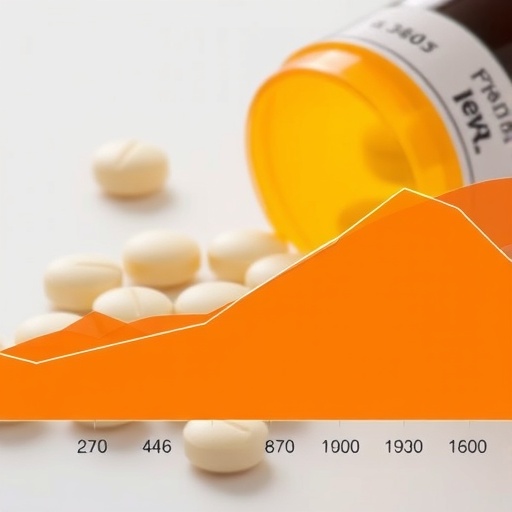Drug use disorder (DUDs), commonly known as drug addiction, remains one of the most formidable global health challenges of our time. Defined by the chronic and relapsing consumption of psychoactive substances despite serious adverse consequences, drug use disorder inflicts a profound toll on individuals and societies worldwide. According to estimates by the UN Office on Drugs and Crime, more than 250 million individuals globally experimented with illegal drugs at least once in 2021. Among this vast cohort, approximately 39.5 million people suffered from diagnosable drug use disorders. This collective burden prompts urgent questions: Are these figures worsening or improving? What trends can scientific methods reveal about the near future of DUDs?
Addressing these questions, a team of researchers from China has undertaken a rigorous epidemiological analysis employing advanced statistical modeling. Drawing upon comprehensive datasets from the Global Burden of Disease Study—compiled meticulously by the Institute for Health Metrics and Evaluation at the University of Washington—the investigators have provided an revealing portrait of changes in drug use disorders over the past three decades. Their findings, published recently in Frontiers in Psychiatry, illuminate complex and somewhat paradoxical trends that demand attention from public health experts and policymakers alike.
At first glance, the raw global counts point to an alarming rise: the annual incidence of DUDs swelled by 36% between 1990 and 2021, escalating from 10 million new cases to 13.6 million cases worldwide. Prevalence, which accounts for all existing cases at a given time, similarly climbed by 34% to reach over 53 million affected individuals. However, this increase must be contextualized against the backdrop of a significant 50% surge in global population over the same period. When population growth is accounted for, the relative prevalence rate of drug use disorder actually reveals a small but meaningful decline of 6%, falling from 709.2 cases per 100,000 in 1990 to 663.8 per 100,000 in 2021.
Despite this modest drop in prevalence rate, the severity of the problem has deepened drastically. The mortality rate attributable directly to drug use increased sharply, registering a 31% rise, from 1.3 deaths per 100,000 population in 1990 to 1.7 deaths per 100,000 in 2021. The absolute number of deaths tells an even more sobering story: drug-related fatalities more than doubled, surging from 61,774 to 137,278 annually. Alongside deaths, the burden of disabilities linked to drug use has expanded exponentially; disability-adjusted life years (DALYs)—which quantify healthy years lost due to both premature death and disability—jumped by 75%, reaching 15.6 million years lost globally as of 2021.
This counterintuitive convergence of a slight relative decline in prevalence but a dramatic rise in mortality and health loss suggests troubling shifts in the nature of drug use and its consequences. According to lead researcher Dr. Ning Zhang of Jinshan Hospital, Fudan University, these dynamics reflect systemic failings in harm reduction strategies and insufficient access to effective treatment. The data do not implicate the emergence of new psychoactive substances as the primary cause; rather, they highlight synergistic harm generated by the interaction of potent drugs like opioids and cocaine combined with deteriorating social determinants and healthcare infrastructure for people who use drugs.
The epidemiological patterns also reveal striking disparities related to socioeconomic context. High-income regions, especially North America and Western Europe, bear a disproportionate burden of drug use disorder impacts. For instance, drug-caused deaths in high-income North America soared more than elevenfold, reaching a staggering 74,451 deaths in 2021. The United States alone exhibited the highest prevalence worldwide, with 3,821.4 cases per 100,000 individuals—the equivalent of nearly 4% of the population affected. Western Europe witnessed an increase in prevalence by 7%, reaching 1,201.2 cases per 100,000 persons. These data underscore that affluence and access to substances can paradoxically correlate with heavier disease burdens without adequate preventive and therapeutic frameworks.
Looking ahead, the projections offered by Zhang and colleagues paint a sobering outlook. Without rapid scaling of overdose prevention efforts, expanded treatment availability, and enhanced harm-reduction programs, deaths linked to drug use are unlikely to abate and may, in fact, escalate further in wealthier regions. Middle-income nations could experience varying trajectories, with some continuing modest improvements. However, areas challenged by aging populations, economic instability, or insufficient healthcare resources risk escalating harms associated with drug use disorder.
Beyond the stark numbers, this report raises crucial questions about the societal and healthcare system responses necessary to mitigate the profound impact of drug addiction. Addressing not only the biological addiction but also the social determinants—such as poverty, unstable housing, and lack of healthcare coverage—will be indispensable for reversing the escalating mortality and disability trends. The multi-faceted nature of this global crisis requires coordinated intervention, blending harm reduction, evidence-based treatment provision, and policy reforms centered on vulnerable populations.
In sum, the shifting epidemiology of drug use disorder over the past three decades presents a paradox shrouded in alarming implications. Despite small gains in relative prevalence rates, the death toll and lost healthy life-years have risen sharply. The findings emphasize that enhancing health outcomes for people with drug use disorders demands urgent, systemic changes in public health infrastructure and resource allocation. Without such transformations, the global burden of addiction will continue to intensify, exacerbating preventable suffering on a hitherto unprecedented scale.
This comprehensive analysis serves as both a wake-up call and a roadmap for international health agencies, governments, and advocacy groups seeking to confront the dual epidemics of substance use and its devastating human costs. The complex interplay of drug potency, social vulnerability, and treatment access captured by this study compels global stakeholders to act decisively and innovatively. Only through sustained, multifactorial engagement can the tide of drug-related morbidity and mortality be reversed in the critical years ahead.
Subject of Research: People
Article Title: The evolving burden of drug use disorders: a comprehensive epidemiological analysis from the 2021 Global Burden of Disease study
News Publication Date: 1-Oct-2025
Web References: 10.3389/fpsyt.2025.1647269
Keywords: Drug use disorder, addiction, epidemiology, Global Burden of Disease, mortality rate, prevalence, opioids, cocaine, harm reduction, disability-adjusted life years, public health, substance use disorder




